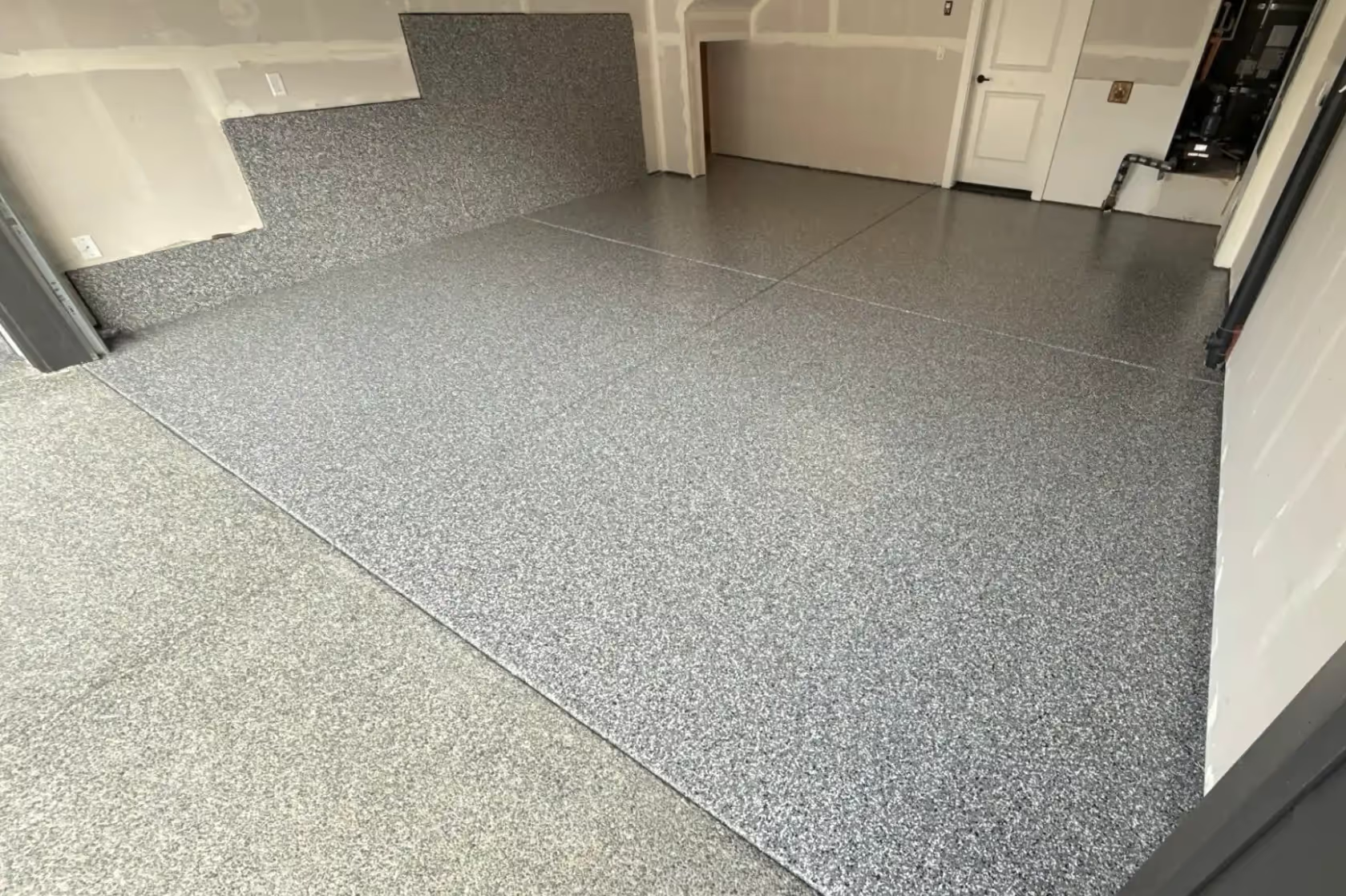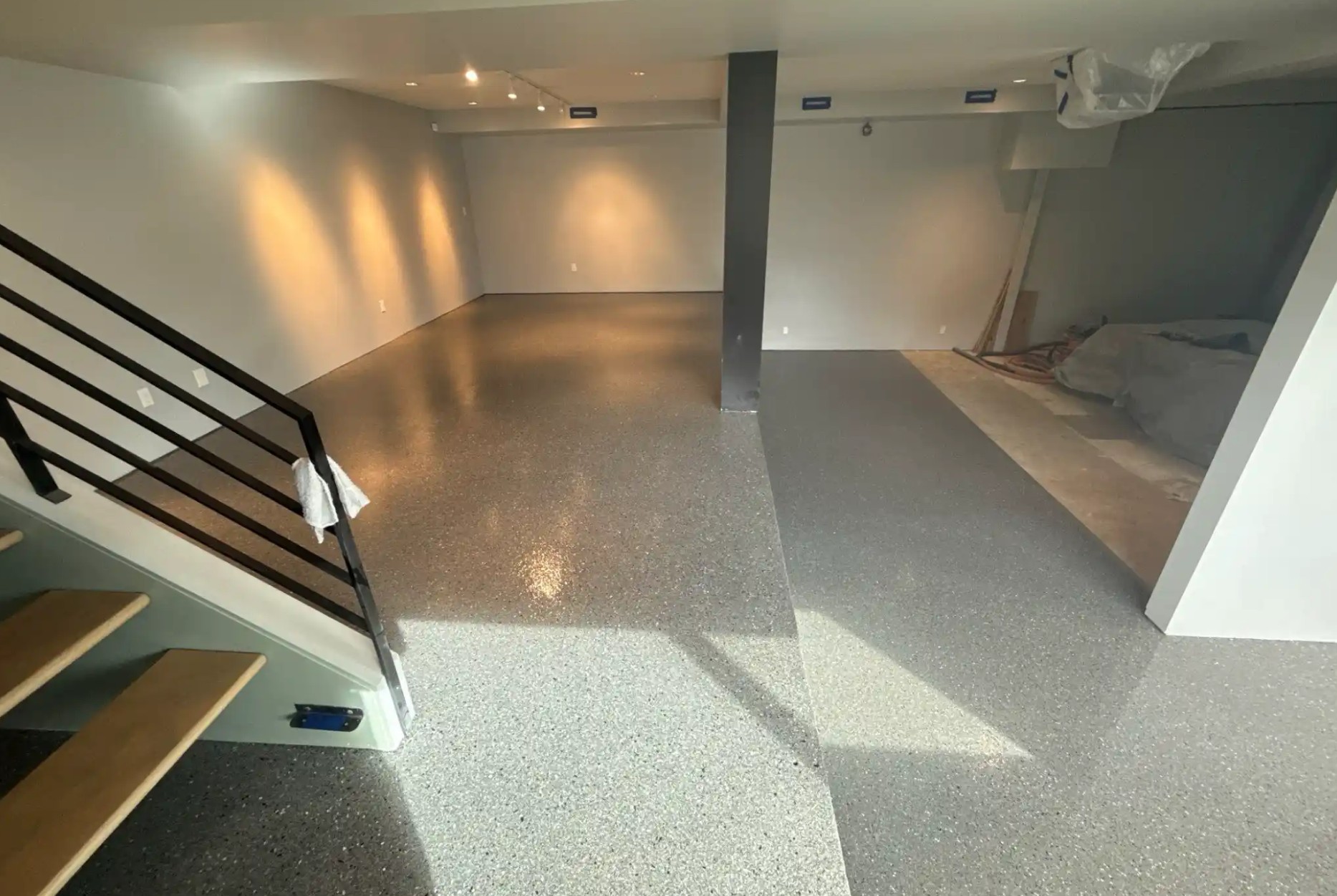
You've just spilled motor oil while changing your car's oil. Or maybe it's transmission fluid, antifreeze, rust remover, or even just red wine from last week's garage party. Now there's a dark stain on your epoxy floor that won't budge no matter how hard you scrub. Sound familiar?
If you're battling stubborn stains on your epoxy garage floor, you're not alone. Thousands of homeowners discover—often too late—that epoxy's shiny appearance masks a fundamental problem: epoxy floors are porous and absorb stains rather than repelling them. What started as an attractive, affordable coating quickly becomes a maintenance nightmare that gets progressively worse over time.
But here's the question most homeowners should be asking: Why are you fighting stains instead of preventing them in the first place?
Before diving into stain removal techniques, it's critical to understand why epoxy floors are so vulnerable to staining. The answer lies in the fundamental chemistry and structure of epoxy coatings.
The Porosity Problem
Despite appearing smooth and glossy when first installed, epoxy coatings are inherently porous at the microscopic level. This porosity means the surface contains countless tiny openings that liquids can penetrate. When oil, chemicals, or other substances contact the surface, they don't just sit on top—they infiltrate into the coating itself.
Initially, these pores may be small enough that staining isn't immediately obvious. But over time, several factors make the problem progressively worse:
The result? A floor that becomes harder to clean and more prone to permanent staining with each passing month.
Why Common Garage Spills Are Particularly Problematic
Garages see some of the most aggressive staining agents found in residential environments:
Each of these substances has unique chemical properties that make them challenging to remove once they've penetrated a porous surface. This is why simple cleaning often fails—you're trying to remove contamination that has become part of the coating itself.
If you're already dealing with stains, here are approaches that may help—though results vary significantly based on how deeply the stain has penetrated and how long it's been present.
Immediate Action (within minutes of the spill):
Important: Never use highly acidic or alkaline cleaners on epoxy, as they can damage the coating and create dull spots or further staining.
Degreasing Approach (for oil-based stains):
Solvent Method (use with extreme caution):
Caution: Harsh solvents can strip epoxy coatings, create dull spots, or cause discoloration. This approach is risky and should be a last resort.
Baking Soda Paste:
Commercial Stain Removers:
Several products are marketed specifically for epoxy floor stains. Follow manufacturer instructions carefully, and always test in a small area first. Results are inconsistent, and some products may damage the coating while removing the stain.
Here's what most epoxy floor companies won't tell you upfront: once a stain has penetrated deeply into epoxy coating, it's often impossible to remove completely without damaging or removing the coating itself.
This is especially true for:
The options at this point are limited and expensive:
Each option has significant drawbacks, which is why the best approach to epoxy floor stains is prevention—or better yet, choosing a coating system that doesn't stain in the first place.
Understanding the progression of epoxy deterioration helps explain why stain removal becomes increasingly futile:
Year 1-2: The coating is relatively new and less porous. Stains can often be cleaned with moderate effort. Many homeowners believe they made a good choice.
Year 2-3: UV exposure, wear patterns, and chemical exposure begin opening microscopic pores. Stains become noticeably harder to clean. Some permanent discoloration appears.
Year 3-5: The coating shows significant wear. Pores have opened substantially, making the floor highly absorbent. Nearly every spill becomes a permanent stain. Cleaning becomes a constant battle.
Year 5+: If the epoxy hasn't already failed through cracking, peeling, or delamination, it's typically severely stained, discolored, and impossible to keep clean. Most homeowners at this stage are researching replacement options.
This deterioration curve is why epoxy floors have a typical lifespan of just 3-5 years in active garage environments. The staining problem is intrinsically linked to the coating's fundamental structure and cannot be solved through better cleaning techniques or maintenance habits.
Rather than fighting an endless battle against stains on a porous surface, the smarter approach is choosing a coating system engineered to repel stains from the start.
The Penntek Non-Porous Advantage
Penntek's pure polyurea coating system creates a fundamentally different surface structure. The Polyaspartic top coat creates a 100% non-porous finish that's designed to be both antibacterial and antimicrobial. This isn't marketing hyperbole—it's a measurable difference in how the coating interacts with potential staining agents.
How Non-Porous Technology Works:
Unlike epoxy's open pore structure, Penntek's topcoat forms a complete barrier at the molecular level. Liquids cannot penetrate the surface because there are no pathways for infiltration. When motor oil, chemicals, or other substances contact the floor, they remain on the surface where they can be easily wiped away.
Real-World Cleaning Comparison:
Independent testing demonstrates the dramatic difference between porous epoxy and non-porous polyurea surfaces. When identical spills are applied to both coatings and left for the same duration:
This difference compounds over time. While epoxy becomes progressively harder to clean as pores open up, Penntek's non-porous topcoat maintains its easy-clean properties throughout its 30-40 year lifespan.
The non-porous advantage extends beyond just preventing oil stains:
Chemical Resistance: The coating withstands most household cleaners, de-icing salts, and automotive fluids without damage or discoloration. You can clean with confidence knowing the products that remove dirt won't harm your floor.
Antimicrobial Protection: The non-porous surface doesn't harbor bacteria, mold, or mildew. This creates a healthier environment and eliminates the musty odors that can develop in porous epoxy floors.
Hot Tire Resistance: While porous epoxy softens under heat and picks up rubber marks and tire imprints, non-porous polyurea maintains its integrity even under thermal stress.
UV Stability: Penntek's FadeLock technology prevents the yellowing and color degradation that makes epoxy floors look dingy and unappealing over time. Your floor maintains its vibrant appearance for decades.
Let's be honest about what life with a staining epoxy floor really costs:
Time Investment: Hours spent scrubbing, treating, and retreating stubborn stains—time that could be spent on more enjoyable activities.
Cleaning Product Expenses: Specialized degreasers, stain removers, and cleaning equipment that provide limited results.
Frustration and Stress: The constant worry about spills and the disappointment of watching your floor deteriorate despite your best efforts.
Reduced Property Value: A stained, discolored garage floor creates a poor impression for potential home buyers.
Replacement Costs: When staining becomes intolerable, you'll pay to remove the failed epoxy and install a new coating—effectively paying twice for the same square footage.
When you factor in the cumulative cost of fighting stains over epoxy's short 3-5 year lifespan, compared to the effortless maintenance of a non-porous coating that lasts 30-40 years, the value proposition becomes clear.
If you're currently dealing with stain removal on an existing epoxy floor, the techniques outlined above may provide temporary relief. But they don't solve the fundamental problem—you're working with a coating system that wasn't designed for the realities of garage use.
For homeowners planning a garage floor coating project, the lesson is simple: choose a coating system based on its long-term maintenance characteristics, not just its initial appearance or cost.
Questions to ask before selecting a coating:
Even the best coating chemistry won't prevent stains if the installation is compromised. Professional installation by certified technicians ensures:
DIY installations and cut-rate contractors frequently fail not because of the coating chemistry, but because improper installation creates defects that accelerate staining and deterioration.
If you're tired of scrubbing stains from your epoxy floor, you have options:
Short-term: Continue using the stain removal techniques outlined above, understanding their limitations and the progressive nature of epoxy's porosity problem.
Long-term: Invest in a coating system engineered for the realities of garage use—a non-porous surface that repels stains rather than absorbing them.
The difference between fighting stains and preventing them is the difference between constant frustration and effortless maintenance. It's the difference between replacing your floor every few years and enjoying decades of worry-free performance.
Key Takeaways:
Ready to stop fighting stains and start enjoying your garage? Explore coating options that are engineered to stay clean and beautiful for decades, not just months. Contact us today for a consultation about transforming your garage with a floor that actually performs as well as it looks.
Your garage deserves better than constant scrubbing and disappointment. Discover what life looks like with a truly stain-resistant floor coating.





